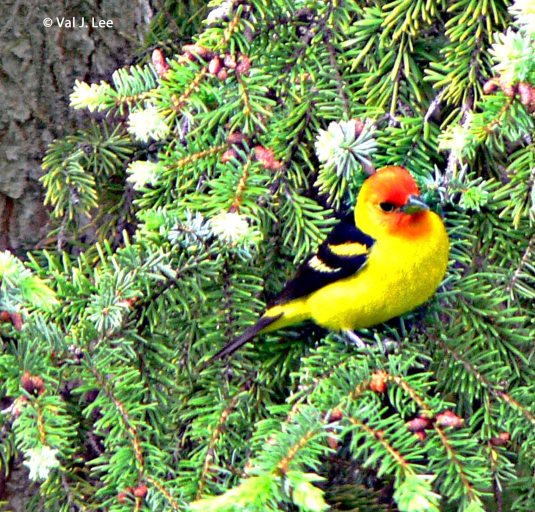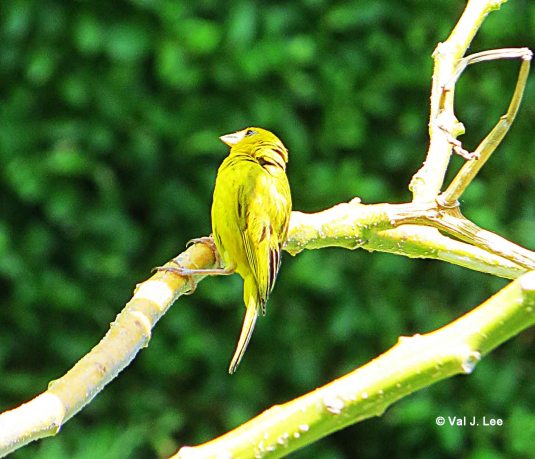My husband and I had a spectacular time feeding this wild Saffron Finch (Sicalis flaveola) on the volcanic Island of Hawaii—A paradise set atop black, molten rock.
This island continues to expand as God touches the volatile volcanoes and makes them smoke and spit their fiery lava skyward. (Psalm 144:5 refers to Almighty God touching the mountains to make them smoke.)
These petite Saffron Finches, sometimes called roof canaries, were plentiful at our vacation stay. They would bask in the sun and stiff grass in search of seeds, bugs and worms. They had no time to pay attention to vacationers who walked by within a few feet.
Saffrons provide pleasant songs, though often high-pitched.
They mate at two years of age and are faithful to their mates, mating for life, as designed by God.
Jesus Christ designed His birds in such a way that 90% are monogamous. Colossians chapter 1, in the Bible, teaches, all things were created by Jesus Christ. He is God the Son who created with God the Father and the Holy Spirit, the Godhead, three in one.

Saffron Finch and English Sparrow (background), © Val J. Lee, Saffron Finch comparison to English Sparrow
“Saffron” explains the color of the finch, yellow to orange, the color of the stigmas of the Mediterranean crocus plant that are dried to sell as a spice, and it is the most costly of herbs. Though you can find it at an inexpensive price at Amazon.
They are a gregarious bird, outside of breeding season; seen in groups with fellow Saffrons, as I observed.
My video of Saffron Finch:
Saffron meals include a mixture of grass seeds, wild seeds, plants, ant eggs, mealworms, wax-worms, and fruit fly larva. They do visit feeders and will sometimes make a nest under an eave of a house. A homeowner may provide a ready-made nest such as a large, elevated, gourd bird house.
It is a Tanager bird from South America. In North America we have the Western Tanager that is far more striking in vibrancy.
The Saffron Finch is common in open and semi-open areas in lowlands. It can be spotted in Colombia, western Ecuador, western Peru, Brazil (here referred to as “native canary”), Bolivia, Paraguay, Uruguay, and northern islands of South America and the Caribbean.
It was introduced to Hawaii and other locals.
Though commonly thought of as a canary, it is not related to this ave.
Saffron Finches, though exotic birds, can be bought in pet stores, and make hardy, caged pets.
Male Saffron Finches are territorial and will fight for a nesting area for he and his bride during mating season. He will even fight unto death and will not only wrestle fellow Saffrons, but also large male birds twice its size.
Due to this aggressive nature, male Saffrons are frequently used as fighting birds in South America. They are the pit bulls of birds. This is referred to as “blood sporting.” Two are placed in a cage to fight until the loser dies. Wagers are placed on the preferred bird. It is not highly favored and authorities will raid locations of the fights.
When a Mr. Saffron spots the gal of his dreams, he will chase her until he has won her heart. At which point, he will court the gal, sitting beside her, romancing her with dancing and songs.
Mommy finches will lay three to five off-white eggs, heavily marked in brown, in a cavity of a tree, crevice in a rock, in an abandoned nest or under an eave of a building, using sticks or bamboo.
Mom incubates the eggs while Dad guards the nest. Incubation is 12 to 14 days. Upon hatching, both parents feed the young and the doting father often checks on his babies.
Baby bird diaper changing involves both the male and female removing the waste from the nest, placing it in their beaks and flying it away.
The young Saffrons resemble their mommies. Hatchlings, are often olive-brown with heavy dark streaks. The males are slightly lighter than the females.
After a few days the chicks fledge (fly from the nest).
A Saffron Finch is over 5 inches in length, weighing in at .7 ounces.
Their flight pattern consists of rapid wing beats with its rounded wings pulled to its sides. Its feathers are black, edged in yellow with yellow-green upper-tail coverts: Covers for all other feathers. Coverts help smooth airflow over the wings and tail.
Adult males are brighter yellow than the females and display an orange crown. Females are more greenish in general. Saffrons, at times, can be difficult to distinguish and often, you see photos at birding sites where the gender is not provided.
God’s manufactured phenomenal wings; blessing birds with an oil gland at the base of their tail, whereby, birds take the oil and cover their wings for weather-proofing while preening or grooming their plumage. This includes aligning their feathers as well. God tells them what to do to for maintenance for perfect piloting.
Birds, in general, can own up to 25,000 feathers. This includes their numerous, itsy bitsy down feathers.
Tanagers experience a molt and also, a half molt. When a bird molts, they lose all their feathers, unless it is a half molt. A complete molt is when they gain a new set of pinions from God. Unfortunately, we humans can never shed our old bodies for new ones. Though true Christians will obtain new bodies one day in heaven.
Most birds molt after the nesting season.
The LORD God blesses Saffron Finches with an average lifespan of 10 years.
In the Bible book of Hosea, God reveals to us, during the millennium, when Jesus Christ rules the earth from Jerusalem, that the birds will be blessed! God will make a covenant with the birds. They will enjoy peace! There will be no more war! They will be able to lie down in complete safety. (Hosea 2:18)
Letter to bird enthusiast:
https://birdsbyval.wordpress.com/2012/03/03/letter-to-bird-enthusiast/
Bird data gratefully gathered from various web sources.
______
My Hawaii Part 2, video with Saffron Finch:
https://www.youtube.com/watch?v=MSs_fdjwNsk&list=UU1q- YrogeWMHltSTdCkspkQ&index=13
Hawaii Part 1, video of volcanos:
https://www.youtube.com/watch?v=T8ukxjxPEIg&list=UU1q-YrogeWMHltSTdCkspkQ






